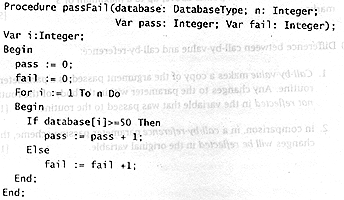| 2. |
(a) Explain the
similarities and differences between a function and a procedure. |
[5] |
|
|
Similarities |
|
|
|
|
both a
function and procedure take a number of arguments as parameters |
|
|
|
|
they both
contain a body of code that is executed when the function/procedure is called. |
|
|
|
|
parameter
variables referenced in the body of the function/procedure use the values of the
parameters that were passed as arguments to the function/procedure. |
|
|
|
|
functions/procedures
may contain local variables that have scope during the lifetime of the function/procedure. |
|
|
|
|
if the
parameters are reference parameters, then any changes to the parameters are
reflected in the data-structures that were passed as the appropriate argument to the
function/procedure. |
|
|
|
Differences |
|
|
|
|
A function
returns a single value as a result. |
|
|
|
|
Function
calls are expressions, whereas procedure calls are statements of the language. |
|
|
1
mark for each of the points above, up to a maximum of 5 marks. |
|
|
[5 marks] |
|
|
|
|
|
(b) Identify the
differences between call-by-value and call-by-reference parameter
passing. |
[2] |
|
|
Call-by-value makes a copy of the argument passed as a parameter to
the routine. Any changes to the parameter within the body of the routine are not
reflected in the variable that was passed to the routine. |
[1] |
|
|
In comparison, in a call-by-reference parameter passing scheme, the
changes will be reflected in the original variable. |
[1] |
|
|
|
|
(c) This question is
concerned with the implementation of routines that analyse a simple "pass mark"
database. The database can contain at most ClassSize records. The various database types
you should use in your routines are shown below.
| Const |
ClassSize |
= 20; |
| Type |
MarkRange |
= 0 . . 100; |
|
DatabaseType |
= Array [1 . . ClassSize] of MarkRange; |
|
|
|
Pass
mark database: |
|
|
|
(i) Define a function
averageMark that takes two arguments: a pass mark database; and an integer n (you can
assume that n < ClassSize) that identifies that the first n elements in the
database contain student marks. The result from the function should be a Real that
represents the average mark. |
[6] |
|
|
A
sample definition of the average mark function is shown below: |
|
|
|
 |
|
|
|
and
the following marking scheme should be used: |
|
|
|
|
one mark for a
function header with a return value Real. |
|
|
|
|
one mark for a
header that contains a DatabaseType, and an integer |
|
|
|
|
one mark for
the initialisation of the variable used as the return result to zero; |
|
|
|
|
one mark for a
for-loop that iterates over n values; |
|
|
|
|
one mark for
incrementing the result variable by each element from the pass mark database |
|
|
|
|
one mark for
dividing the sum of the marks by n |
|
|
|
do
not deduct marks for trivial syntactic errors when making the above points. |
|
|
|
[6 marks] |
|
|
|
(ii) Define a procedure
passFail that takes as its arguments a database of marks and an integer n (you can assume
that n < ClassSize) that identifies the number of pass marks in the database,
and returns two results: the number of candidates that obtained a pass (i.e., a pass mark >
50); and those that failed. |
[7] |
|
|
A
sample definition of the pass-fail function is shown below: |
|
|
|
 |
|
|
|
and
the following marking scheme should be used: |
|
|
|
|
one mark for
the procedure header that contains a DatabaseType and an integer with no return type
(i.e., the definition of a procedure not a function). |
|
|
|
|
one mark for
correct use of Var in header. |
|
|
|
|
one mark for
identifying that pass and fail are reference parameters. |
|
|
|
|
one mark for
initialising the pass and fail variables to zero; |
|
|
|
|
one mark for
defining a for-loop that iterates over n values. |
|
|
|
|
one mark for
incrementing pass when the ith element in the database is greater than or equal
to 50. |
|
|
|
|
one mark for
incrementing fail when the ith element in the database is less than 50. |
|
|
|
do
not deduct marks trivial syntactic errors when marking the above points. |
|
|
|
[7 marks] |
|

